Public relations strategies for gaming platforms need a fresh approach to connect with Gen Z and Gen Alpha audiences. These digital natives, born between 1997-2012 and 2010-2024 respectively, respond differently to traditional marketing methods compared to previous generations. Their media consumption habits center around mobile devices, social platforms, and authentic content from trusted voices. Gaming companies must adapt their PR tactics to meet these younger players where they spend their time, using methods that feel natural and engaging rather than promotional. This shift requires understanding the unique characteristics of these generations and implementing targeted strategies that align with their values and preferences.
PR Overview
Understanding Gen Z and Gen Alpha Gaming Audiences
Young gamers today show distinct preferences in how they consume content and interact with gaming brands. Research from Marketing Dive shows that Gen Alpha, in particular, gravitates toward interactive experiences within gaming environments like Roblox and Minecraft. These players value authenticity, community participation, and creative expression above traditional advertising messages.
Social media platforms play a central role in how younger audiences discover and engage with games. According to Global Toy News, mobile gaming content receives up to 6 times higher engagement rates compared to traditional advertising formats when targeting these demographics. This engagement stems from their preference for participatory experiences over passive content consumption.
Mobile-First PR Strategies
Mobile optimization stands as a cornerstone of successful PR campaigns targeting younger gaming audiences. With smartphones serving as their primary gaming and content consumption device, PR teams must prioritize mobile-friendly formats and experiences.
Short-form video content performs particularly well on mobile platforms. These brief, engaging clips allow gaming brands to showcase features, updates, and community highlights in a format that matches younger users’ attention patterns. Companies should focus on creating vertical video content optimized for mobile viewing, ensuring smooth playback and clear messaging even on smaller screens.
Interactive content forms another crucial component of mobile PR strategies. Playable ads, augmented reality filters, and in-game activations provide hands-on experiences that resonate with younger players. These formats allow users to engage directly with brand content rather than simply viewing it passively.
Influencer Partnerships and Authentic Storytelling
Gaming influencers hold significant sway over younger audiences’ gaming choices and platform preferences. Successful PR campaigns often involve partnerships with content creators who maintain genuine connections with their communities.
When selecting influencer partners, focus on those who demonstrate authentic enthusiasm for gaming and maintain strong engagement with their followers. According to marketing research, partnerships work best when influencers already use and enjoy the games they promote, leading to more natural and credible content creation.
Content collaboration should emphasize storytelling that feels native to gaming culture. This means moving beyond traditional promotional messaging to create content that adds value to the community through entertainment, education, or shared experiences.
Social media challenges represent a powerful tool for building community engagement around gaming platforms. These initiatives encourage user participation while generating organic reach through shared content.
Creating effective gaming challenges requires understanding platform-specific dynamics:
- TikTok challenges should focus on short, repeatable actions that showcase gameplay or community creativity
- Instagram challenges work well for visual content highlighting in-game achievements or customization
- Discord events can foster deeper community discussions and collaborative activities
Successful challenges often incorporate trending elements from gaming culture while maintaining clear connections to the platform or game being promoted. This approach helps ensure organic participation and sharing among target audiences.
Measuring Impact and Success
Tracking PR campaign effectiveness requires monitoring specific metrics that matter to younger gaming audiences. Key performance indicators should include:
- Engagement rates across social platforms
- User-generated content volume
- Community growth metrics
- Sentiment analysis results
- Platform adoption rates among target demographics
Tools designed specifically for gaming analytics help track these metrics effectively. Regular analysis allows PR teams to refine their approaches based on real performance data rather than assumptions about younger audience preferences.
Building Trust Through Transparency
Young gamers value transparency from gaming platforms and brands. PR initiatives should maintain clear communication about features, updates, and community policies. This openness helps build long-term trust with younger audiences who often show skepticism toward traditional marketing approaches.
Regular community updates, behind-the-scenes content, and direct engagement with player feedback demonstrate commitment to transparency. These practices help establish genuine connections with younger players while fostering platform loyalty.
Safety and Responsibility
PR strategies targeting younger gaming audiences must prioritize safety and responsible gaming practices. This includes clear communication about:
- Age-appropriate content guidelines
- Online safety features
- Parental controls
- Screen time management tools
- Community behavior standards
Demonstrating commitment to user safety helps build trust with both young players and their parents or guardians.
Conclusion
Successfully attracting younger audiences to gaming platforms through PR requires a comprehensive approach that prioritizes mobile experiences, authentic partnerships, and community engagement. Focus on creating genuine connections through interactive content, influencer collaborations, and social media challenges while maintaining transparency and safety standards.
Start by evaluating your current PR strategies against these modern requirements. Identify areas where mobile optimization could improve, potential influencer partnerships that align with your brand values, and opportunities for community-driven content creation. Remember to maintain consistent measurement of your efforts, adjusting tactics based on performance data and audience feedback.
Success in reaching younger gaming audiences comes from understanding their preferences and meeting them on their terms. By implementing these strategies thoughtfully and authentically, gaming platforms can build lasting connections with Gen Z and Gen Alpha players.
The Role of Gamification in Digital Health Engagement
Health apps sit on millions of phones, downloaded with good intentions but rarely opened after the...
AdTech and Gaming PR Strategies: Reaching Digital Audiences in 2025
Gaming has become the world's most profitable entertainment sector, with over 3.2 billion players...
The Impact of Digital PR on Fintech Growth
Digital public relations has become a defining force in fintech success, with data showing that...




